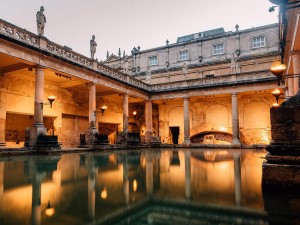Bath’s tourism sector and its heritage conservation are set for a timely shot in the arm following the city achieving its second World Heritage listing.
Bath, along with 10 other historic spa towns, secured the much-coveted UNESCO status as members of the ‘Great Spa Towns of Europe’.

The decision by the 44th UNESCO World Heritage Committee means Bath is the only UK city to appear twice on the World Heritage list, putting it alongside a select band of other European cities with a ‘double mention’, including Bruges and Barcelona.
Bath is the only one of the Great Spa Towns to already have World Heritage status, having been classified in 1987, when it was included as a ‘cultural site’.
The Great Spa Towns of Europe will now work together to market themselves across the world in terms of not just heritage, but also wellbeing and health tourism – a global market that is growing exponentially.
The UNESCO inscription highlights the importance of spa culture and architecture as a European phenomenon from 1700 to the 1930s. Among hundreds of spas only a handful of these, including Bath, remain in a good state of conservation.
Bath’s ‘double’ came as World Heritage status was again in the spotlight following UNESCO’s decision to strip Liverpool of its listing over redevelopment of its historic waterfront – only the third place to lose the coveted title in nearly 50 years.

And in an interview with The Guardian today, UNESCO World Heritage Centre director Dr Mechtild Rössler, warned other UK cultural landmarks could similarly lose their status unless the government curbed what he called “ill-advised development” and protected the sites for future generations.
It also comes hot on the heels of iconic international magazine TIME naming Bath among the 100 greatest places in the world – one of only two destinations in England to appear in prestigious annual list.
The Great Spas of Europe project, which is supported by Bath & North East Somerset Council (B&NES), is an international collaboration led by the Czech Republic and includes Austria, Belgium, France, Germany, Italy and the UK.
B&NES cabinet member for children and young people, communities and culture, Dine Romero, said: “This inscription is a confirmation of the exceptional historic value of Bath.
“Our architectural and archaeological quality is already recognised, but this new accolade underlines the influence that the hot springs have had on the city.
“This is not just about history, as moving forward Bath will continue to successfully blend our outstanding heritage and wellbeing offer with our vibrant modern city.”

Lead councillor for the project Ruth Malloy, pictured, added: “Bath was included in this elite group through merit as you cannot fully tell the story of European spa culture without it.
“Realising the opportunity of a very rare second inscription has involved many years of hard work but it now offers us benefits of enhanced cooperation in the fields of heritage conservation, health tourism and visitor marketing.
“I would like to thank all of our partners who have worked so successfully in this excellent example of European co-operation.”
Heritage minister Caroline Dinenage described the listing as testament to the role Bath had played in the country’s history.
“For thousands of years people have flocked to the city to experience its healing waters and I’m delighted that this inscription will protect this historic location for future generations,” she said.
The Great Spa Towns of Europe project focuses on historic spa towns based around mineral springs which formed fashionable resorts of health, leisure and recreational ‘diversions’, such as gambling and dancing from the 18th to the early 20th centuries.
The towns were built in harmony with their natural therapeutic landscape settings to create unique urban forms. They were the pioneers of modern tourism and, although often small in size, they attracted guests who might otherwise only gather in great metropolises and capital cities.
Only a few spas rose to great prominence and of those only a few remain in a good state of conservation.
The Great Spa Towns of Europe are Bath, Baden bei Wien (Austria), Spa (Belgium), Vichy (France), Baden-Baden, Bad Ems and Bad Kissingen (Germany), Montecatini Terme (Italy), and Karlovy Vary, Mariánské Lázně and Františkovy Lázně (Czech Republic).
The UNESCO inscription is transnational, meaning the 11 towns are regarded as a single World Heritage Site.



















